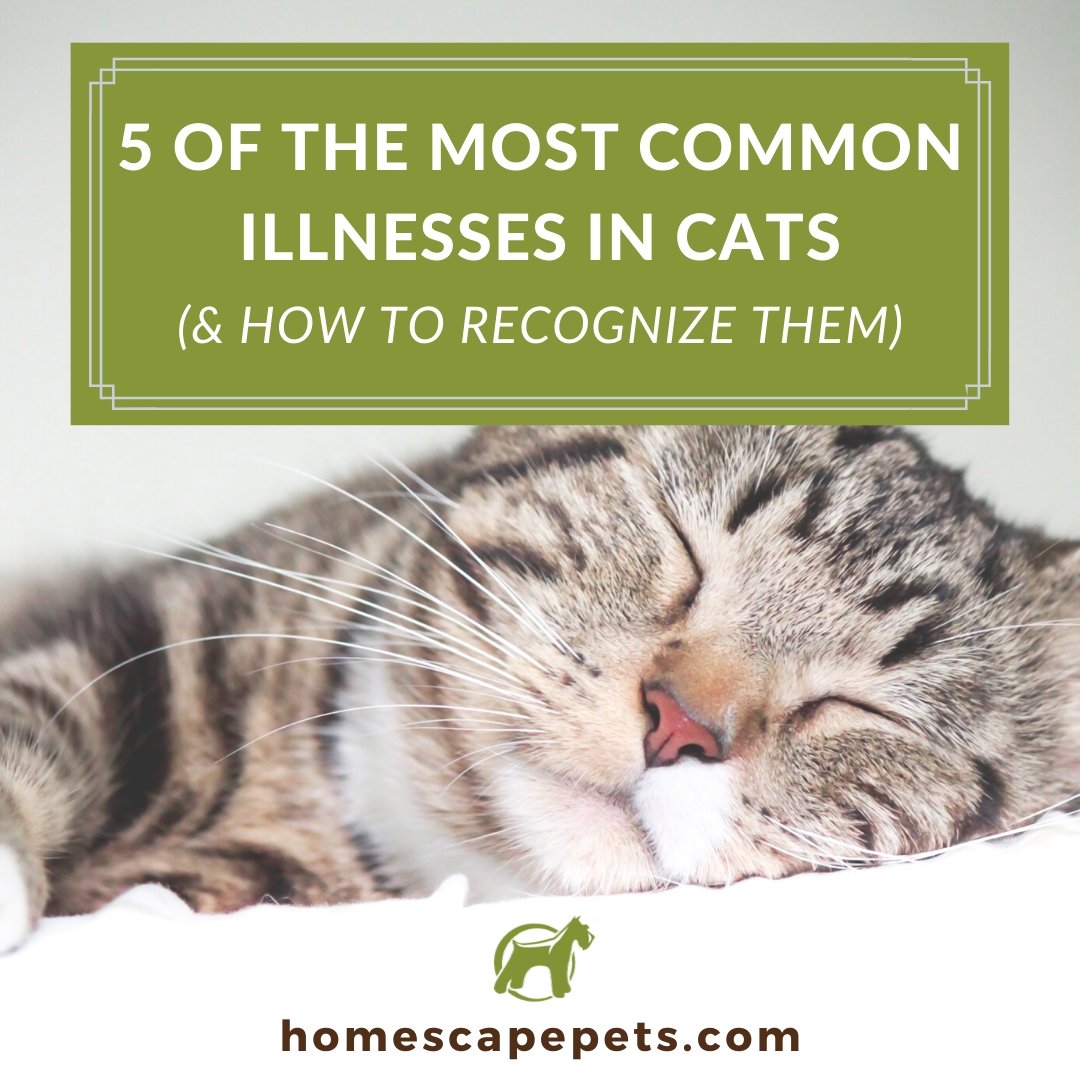
5 of the Most Common Illnesses in Cats (& How to Recognize Them)
Share
There are countless reasons that cat parenting is so popular, and we’re certainly no stranger to the irresistible charms of having a feline run your household! Cats seem to have the reputation of being more “low maintenance” than pups because of their tendency to be independent creatures (whether they’re affectionate or not). And although every cat has his or her own personality, they’re less likely to be expressive… and that much more difficult to read.
For that reason, some kitties may be suffering in silence from common feline diseases like FIV (which is discussed later) before their parents get to recognize the signs. When it comes to taking care of fur-babies, we know that knowledge is power and that knowing what to look out for before it’s too late can make all the difference.

Here are 5 of the most common cat ailments to look out for:
Feline Leukemia Virus (FeLV)
Feline leukemia is a transmittable virus that is one of the most commonly diagnosed causes of illness and fatality in household cats. Like FIV, FeLV works to weaken your cat’s immune system and make him or her vulnerable to other diseases, including other aggressive cancers. Some cats who are infected show no signs, but here are some common symptoms other cats will demonstrate:
- Decreased appetite and weight loss
- Abscesses and abnormal growths
- Seizures
- Diarrhea and vomiting
- Jaundice (yellow discoloration)
- Enlarged lymph nodes
- Inflammation of the gums
- Behavioral changes like lethargy
- Eye problems
Although there’s no surefire guarantee against FeLV, there are vaccines available (along with some risks). You should discuss what’s right for your cat with your veterinarian, but routine FeLV testing will help eliminate the risks of infection.
Kidney Disease or Renal Failure
More common in older cats, there are two types of kidney diseases: acute renal failure and chronic kidney problems. If diagnosed in time, kidney failure can actually be reversed, while chronic kidney problems are more common in older cats and harder to treat. But acute renal failure develops quickly over days or weeks and can happen in cats of all ages as the result of:
- Poisoning, the most common cause of acute renal failure. Toxic chemicals, plants, and other toxic household items like over-the-counter human medication can lead to kidney failure in cats.
- Physical trauma
- The shock from rapid dehydration or overheating
- Kidney infection
- Kidney blockages (common in male cats who can’t pee due to urethral blockages)
If your cat is frequently urinating (and therefore frequently drinking a lot of water), and/or urinating outside of the box, you should take him or her into the vet. Here are other signs of kidney diseases in cats:
- Weight loss and loss of appetite
- Vomiting, diarrhea
- Constipation
- Cloudy or bloody urine
- Lethargy and weakness
- Oral issues such as abnormally bad breath, oral ulcers, and tongue discoloration
Lower Urinary Tract Disease (FLUTD)
Lower urinary tract disease is used to describe many different conditions that occur in your cat’s bladder or urethra. One common cause of FLUTD is blockages in your cat’s urethra, the tube that carries the flow of urine from the bladder to the outside of your cat’s body.
Cats can develop FLUTD at any age, but it occurs more commonly in older or overweight cats with poor diets. Other factors like environmental or emotional stress can increase the likelihood that your cat will develop FLUTD. Here’s what to look out for:
- Difficulty and straining during urination
- Only urinating small amounts
- Crying while urinating, or even crying when your cat is preparing to urinate (stress)
- Excessive genital licking
- Peeing outside the box
- Blood in the urine
One thing that’s important to note that urethral blockages are more common in males due to a longer and narrower urethra, and is considered a medical emergency requiring immediate care.
Feline Immunodeficiency Virus (FIV)
Unfortunately, the symptoms of FIV may not show up in your kitty until years after she was initially infected. The virus is slow-acting, but over time will work to weaken your cat’s immune system until they are then vulnerable to secondary infections and ailments. You should immediately schedule an appointment with your veterinarian if your cat is exhibiting any of these symptoms:
- Poor coat quality
- Weight loss
- Decreased appetite
- Diarrhea or frequent urination
- Dental issues like gum or mouth inflammation
- Enlarged lymph nodes
- Inflammation of the eye (conjunctivitis or pinkeye)
- Nasal or eye discharge
- Wounds that won’t heal
- Cold-like symptoms, like fever and sneezing
FIV is more common in outdoor cats or cats who were once homeless and then fostered, which is why many pet parents have their vets test for FIV upon adoption. If your cat is an indoor cat, then the best way to prevent FIV is to avoid any chance that she or he will be exposed to another infected cat. The good news is cats who are tested positive for FIV can potentially live long, healthy years if they are given the right medical support.
Upper Respiratory Infections
Upper respiratory infections (URIs) are especially common in kittens, but many adult household cats run the risk of developing this infection, too. Viruses are the cause of 80-90% of respiratory problems in cats and are highly contagious which is why they are most commonly seen in shelters and multi-cat households. There are also bacterial causes to URIs, like chlamydia and bordetella. Here’s how you can detect URIs in your cat:
- Cold symptoms like sneezing, runny nose, congestion, and cough
- Nasal discharge and itchy eyes
- Difficult or rapid breathing
- Gagging and drooling
- Decreased appetite
- Behavioral changes like depression and lethargy
If your cat has a URI but is left untreated, he or she can develop pneumonia, blindness, or chronic and long-lasting difficulty with breathing. However, your cat can be properly treated for a URI and go on to live a long, healthy, and happy life. Your veterinarian should be able to quickly diagnose an upper respiratory infection and provide the right treatment for your cat.
You may have noticed that many of these common ailments carry the same or similar symptoms, which makes some of them even harder to diagnose. That’s why you should never self-diagnose. These diseases require specific medical treatments that are just right for your pet. And while not all of these ailments are entirely curable, Homescape Pets can help ensure your pet is living the best life she or he can live under these conditions.
We’ve worked hard to develop supplements to support cats who suffer from these common conditions, especially since many of the signs and symptoms are so similar. For instance, our Calming Relief Hemp & Turmeric Oil for Pets is formulated with organic hempseed oil because its Omega-6 and Omega-3 properties help support healthy organ and immune functions as well as help soothe their aches and pains.
We made the choice to commit ourselves to all-natural wellness that pet parents like you can make the choice to give your pet a happier life, especially if they suffer from common illnesses (or as a preventative measure). Don’t let a bad diagnosis stop your pet from having a good life. Check out Calming Relief Hemp & Turmeric Oil for Pets and see!
